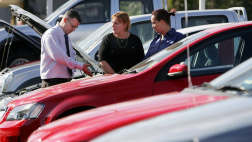An Australia-patented gas-injection system has surfaced as the reason for choking the plans of Hyundai and Kia to import their innovative LPi-Hybrid models. This is contrary to the official line - quoted at the Kia Koup launch in Seoul early last year - that Kia was "having difficulty" adjusting to Australia's propane-rich LPG mix.
Korea, and many other gas-producing nations, have LPG that is richer in butane. Technically, adjusting between the two LPG blends is a matter of engine management tuning.
But Kia - and later Hyundai, which shares the LPG injection technology - indicated it was all too hard and killed plans to bring its gas-electric Cerato to Australia.
But there was a more compelling argument. The LPi (liquid petroleum injection) hybrid - sold in Korea and now readying for export to countries except Australia - has components within its gas-injection system that are patented by a Melbourne engineering company.
Kia last year planned to import its Cerato LPi-Hybrid sedan but mysteriously - and suddenly - developed cold feet. Its associate company, Hyundai, had a similar-engined car ready to export but froze the plan.
The Australian patent holder, engineering company LPG-Liquid-Inject Ltd, says the technology being used by companies including Hyundai-Kia dates back to the mid-1990s.
LPG-Liquid-Inject director John Martin says his company contacted Hyundai-Kia when news of an LPG-Hybrid car was announced. His patents also cover the common Vialle LPG injection system used by Ford - and provided by Perth-based Orbital Corporation - which is currently in dispute over patent breaches.
"We have been challenged by Vialle on our patent four times and they have failed," Mr Martin says. "They know that our patents have 12 months to run before they expire, so they're developing a market now."
But Mr Martin says carmakers aiming to capitalise when the patents expire are investing in redundant technology. "We're within a whisker of finalising this new technology," he says.
"It's cheaper, more efficient, has instant starting and automatically adjusts for different butane/propane proportions in LPG." LPG-Liquid-Inject Ltd is also completing is own LPG-engine and electric motors hybrid, using a 650cc internal-combustion engine powering a generator to charge a composite of lead-acid and lithium-ion batteries and then driving hub motors within the wheels of a 5.5-tonne Transit van.
"We can produce the system in Australia and we have an engine-maker (in Victoria) ready to build it,' Mr Martin says. "But we can't get any government assistance. The Federal Government is only interested in big car companies and big car component suppliers who have lots of employees.
"So we plan to have it built in Britain. It is bad for Australia because we want to live here. And it makes doing business in Australia look bad."
In 2008, Mr Martin's company was relying on a Commercial Ready development grant of $400,000 from the Federal Government to commercialise his technology. But the grant scheme was cancelled.
In 2009 the Federal Government granted $35 million to Toyota to build its Camry Hybrid in Melbourne. The policy manager of LPG Australia, Steve Reynolds, says Mr Martin's work represented "very good home-grown technology that we see as being important in increasing the range of LPG automotive products on the market".





.jpg)
.jpg)

.jpg)
_0.jpg)


.jpg)




.jpg)
.jpg)




.jpg)
.jpg)




